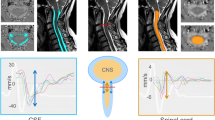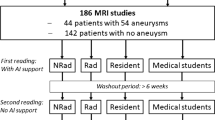Abstract
Background
Faster and motion robust magnetic resonance imaging (MRI) sequences are desirable in pediatric brain MRI as they can help reduce the need for monitored anesthesia care, which is a costly and limited resource that carries medical risks.
Objective
To evaluate the diagnostic equivalency of commercially available accelerated motion robust MR sequences relative to standard sequences.
Materials and methods
This was an institutional review board-approved prospective study. Subjects underwent a clinical brain MRI using conventional multiplanar images at 3 Tesla followed by fast axial T2 and FLAIR (fluid-attenuated inversion recovery) sequences optimized for an approximately 50% reduction in acquisition time. Conventional and fast images from each subject were reviewed by two blinded pediatric neuroradiologists. The readers evaluated the presence of 12 findings. Intra-observer agreement was estimated for fast versus conventional sequences. For each set of sequences, interobserver agreement calculations and chi-square tests were used to evaluate differences between fast and conventional acquisitions. An independent third reader reviewed the intra-observer discrepancies and adjudicated them as being more conspicuous on fast sequence, conventional sequence or the equivalent. The readers also were asked to rate motion artifacts with a previously validated score.
Results
Images from 77 children (mean age: 11.3 years) were analyzed. Intra-observer agreement (fast versus conventional) ranged between 89.2% and 92.3%. Interobserver agreement ranged between 86.1% and 88.4%. Interobserver agreement was significantly higher for conventional FLAIR relative to fast FLAIR for small (<5 mm) foci of T2 in the white matter. Otherwise, interobserver agreement was not different between the fast and conventional sequences. For awake subjects, fast sequences had significantly fewer artifacts (P<0.05).
Conclusion
Conventional T2 and FLAIR sequences can be optimized to shorten acquisition while maintaining diagnostic equivalency. These faster sequences were also less susceptible to motion artifacts.






Similar content being viewed by others
References
Robertson RL, Silk S, Ecklund K et al (2018) Imaging optimization in children. J Am Coll Radiol 15:440–443
Jaimes C, Gee MS (2016) Strategies to minimize sedation in pediatric body magnetic resonance imaging. Pediatr Radiol 46:916–927
Vanderby SA, Babyn PS, Carter MW et al (2010) Effect of anesthesia and sedation on pediatric MR imaging patient flow. Radiology 256:229–237
Jaimes C, Murcia DJ, Miguel K et al (2018) Identification of quality improvement areas in pediatric MRI from analysis of patient safety reports. Pediatr Radiol 48:66–73
Afacan O, Erem B, Roby DP et al (2016) Evaluation of motion and its effect on brain magnetic resonance image quality in children. Pediatr Radiol 46:1728–1735
Jaimes C, Kirsch JE, Gee MS (2018) Fast, free-breathing and motion-minimized techniques for pediatric body magnetic resonance imaging. Pediatr Radiol 48:1197–1208
Bilgic B, Gagoski BA, Cauley SF et al (2015) Wave-CAIPI for highly accelerated 3D imaging. Magn Reson Med 73:2152–2162
Prakkamakul S, Witzel T, Huang S et al (2016) Ultrafast brain MRI: clinical deployment and comparison to conventional brain MRI at 3T. J Neuroimaging 26:503–510
Fagundes J, Longo MG, Huang SY et al (2017) Diagnostic performance of a 10-minute gadolinium-enhanced brain MRI protocol compared with the standard clinical protocol for detection of intracranial enhancing lesions. AJNR Am J Neuroradiol 38:1689–1694
Trofimova A, Kadom N (2019) Added value from abbreviated brain MRI in children with headache. AJR Am J Roentgenol 12:1–6
Saleh A, Wenserski F, Cohnen M et al (2004) Exclusion of brain lesions: is MR contrast medium required after a negative fluid-attenuated inversion recovery sequence? Br J Radiol 77:183–188
Uffman JC, Tumin D, Raman V et al (2017) MRI utilization and the associated use of sedation and anesthesia in a pediatric ACO. J Am Coll Radiol 14:924–930
Strauss S, Gavish E, Gottlieb P, Katsnelson L (2007) Interobserver and intraobserver variability in the sonographic assessment of fatty liver. AJR Am J Roentgenol 189:W320–W323
Redondo A, Comas M, Macia F et al (2012) Inter- and intraradiologist variability in the BI-RADS assessment and breast density categories for screening mammograms. Br J Radiol 85:1465–1470
Schnetzke M, Schuler S, Hoffend J et al (2017) Interobserver and intraobserver agreement of ligamentous injuries on conventional MRI after simple elbow dislocation. BMC Musculoskelet Disord 18:85
Bayram E, Topcu Y, Karaoglu P et al (2013) Incidental white matter lesions in children presenting with headache. Headache 53:970–976
Schmidt RL, Factor RE (2013) Understanding sources of bias in diagnostic accuracy studies. Arch Pathol Lab Med 137:558–565
Acknowledgments
Camilo Jaimes was partially supported by the Ralph Schlaeger Fellowship in Neuroimaging Endowment and the Young Investigator Award of the Society for Pediatric Radiology.
Author information
Authors and Affiliations
Corresponding author
Ethics declarations
Conflicts of interest
None
Additional information
Publisher’s note
Springer Nature remains neutral with regard to jurisdictional claims in published maps and institutional affiliations.
Rights and permissions
About this article
Cite this article
Jaimes, C., Yang, E., Connaughton, P. et al. Diagnostic equivalency of fast T2 and FLAIR sequences for pediatric brain MRI: a pilot study. Pediatr Radiol 50, 550–559 (2020). https://doi.org/10.1007/s00247-019-04584-1
Received:
Revised:
Accepted:
Published:
Issue Date:
DOI: https://doi.org/10.1007/s00247-019-04584-1




